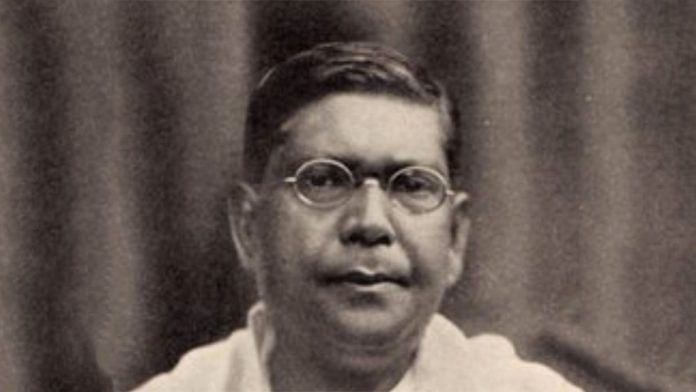New Delhi: C.R. Das served as the Indian National Congress president for a session and co-founded the Swaraj Party, but almost over a century later, he is remembered as ‘Deshbandhu’, or ‘friend of the nation’, as the people of his times affectionately called him.
Das’ political career lasted only six years, but it came after he jumped into India’s freedom struggle as a lawyer and helped many revolutionaries.
Entry into legal career
Das was born on 5 November 1870 in Calcutta (now Kolkata) in present-day West Bengal to an upper middle-class Vaidya family. His father, Bhuban Mohan Das, was a solicitor at the Calcutta High Court.
Das completed his graduation from Presidency College in 1890. The same year, he went to England to qualify for the ICS, which was dominated by the British. Unfortunately, he failed. As a result, he opted to join the legal profession. Das practiced law at The Honourable Society of the Inner Temple at London in England.
While in England, Das campaigned for Dadabhai Naoroji to help win a seat in the House of Commons from Central Finsbury. Naoroji became the first Asian in 1892 to become a part of the Westminster.
Two years later, Das came back to India and started practising as a barrister at Calcutta High Court.
As a lawyer, Das defended Indians who were accused of political offences. He appeared in defence of freedom fighters Brahmabandhab Upadhyay and Bhupendranath Datta who were charged with sedition.
In 1908, Das attained widespread fame when he was successfully able to defend Aurobindo Ghose in the Alipore Bomb Case — a bomb explosion in Muzaffarpur had killed two women and Ghose was the main accused. Das, with a meticulous handling of the case, concluded his address in the Calcutta High Court with an impassioned appeal and got Ghose acquitted.
He also had a close association with Bipin Chandra Pal, of the Lal-Bal-Pal trio, and supported both him and Ghose in publishing the English weekly Bande Matram.
Political career
Das’ political career spanned just six years, but even in that brief period he managed to leave a mark.
He entered active politics in 1917 when he played “a significant role in the controversy over the election of Mrs Annie Besant as President of the Indian National Congress for its Calcutta Session”, as the party website describes it.
He was a believer in the ‘Swadeshi’ idea and completely rejected the notion of development as promoted by Western powers. In the Calcutta session, he put forward a plan for village reconstruction, which was to entail steps such as establishment of local self-government, co-operative credit societies as well as re-starting the cottage industry.
The next year, he denounced the Montagu-Chelmsford reforms, which were aimed at installing a dual government system or dyarchy in the country.
In 1920, Das sacrificed all his luxuries and supported the cause of ‘khadi’. The same year he participated in Mahatma Gandhi-led Non-Cooperation Movement. During the movement, he also initiated a ban on British clothes in Bengal.
Das was jailed alongside his wife and son for six months for participating in the movement in 1921. The same year he was elected to Ahmedabad Congress.
Also read: Rajiv Gandhi – the ‘unwilling’ PM who laid the foundation of a modern India
Swaraj Party
On 4 February 1922, Mahatma Gandhi suddenly ended the movement following the Chauri Chaura incident. Das was firmly against Gandhi’s move.
At the Gaya session of the party in December 1922, Das was chosen as the Congress president, but resigned later when his plan to introduce non-cooperation from within the councils failed to go through.
Alongside Motilal Nehru, Das then established the Swaraj party within the Congress. The aim of the newly-founded party was to contest in the Central Legislative Assembly in 1923 and derail the British rule through anti-government activities within the council chambers.
The party was able to secure only 40 seats and the number was too small to make any legislative impact. Following the death of Das on 16 June 1925, it was eventually disbanded.
In the book Sucheta Kriplani: Her contribution to political, economic and social development, edited by Verinder Grover and Ranjana Arora, the writers quote Mahatma Gandhi’s affectionate words for Das when the senior leader was with him in Darjeeling in May 1925, just a month before his death.
“When I left Darjeeling I left much more than I had ever thought before. There was no end of my affection for ‘Deshbandhu’ and my warm feeling for such a great soul,” Gandhi had said.
Also read: Motilal Nehru, ‘moderate’ Congress freedom fighter who fought for self-rule




Interesting profile of the person. Though i was hoping that it would go into more detail regarding his life.
Today, it is the death anniversary of CR Das and not birth anniversary as you have mentioned in the subtitle. Kindly look at the facts before publish as many children use these articles for their exams.
Here is a factual error. Chittaranjan Das was born on 5 th November, 1870 at Telirbag, Bikrampur, Dhaka, in East Bengal (now Bangladesh). Please rectify the error.